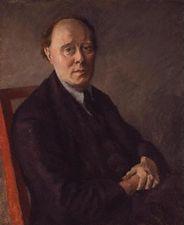
Portrait of Clive Bell by Roger Fry
Clive Bell (16 September
1881 – 18 September 1964) was an English formalist art
critic. He was a member of the Bloomsbury Group.
Ideas
Bell was one of the most prominent proponents of formalism in
aesthetics. In general formalism (which can be traced back at
least to Kant) is the view that it is an object's formal
properties which make something art, or which define aesthetic
experiences. Bell proposed that nothing else about an object is
in any way relevant to assessing whether it is a work of art, or
aesthetically valuable. What a painting represents, for example,
is completely irrelevant to evaluating it aesthetically.
Consequently, he believed that knowledge of the historical
context of a painting, or the intention of the painter is
unnecessary for the appreciation of visual art. He wrote: "to
appreciate a work of art we need bring with us nothing from
life, no knowledge of its ideas and affairs, no familiarity with
its emotions" (Bell, 27).
Formalist theories differ according to how the notion of 'form'
is understood. For Kant, it meant roughly the shape of an object
– colour was not an element in the form of an object. For Bell,
by contrast, "the distinction between form and colour is an
unreal one; you cannot conceive of a colorless space; neither
can you conceive a formless relation of colors" (Bell p19). Bell
famously coined the term 'significant form' to describe the
distinctive type of "combination of lines and colours" which
makes an object a work of art.
Bell was also a key proponent of the claim that the value of art
lies in its ability to produce a distinctive aesthetic
experience in the viewer. Bell called this experience "aesthetic
emotion". He defined it as that experience which is aroused by
significant form. He also suggested that the reason we
experience aesthetic emotion in response to the significant form
of a work of art was that we perceive that form as an expression
of an experience the artist has. The artist's experience in
turn, he suggested, was the experience of seeing ordinary
objects in the world as pure form: the experience one has when
one sees something not as a means to something else, but as an
end in itself (Bell, 45).
Bell believed that ultimately the value of anything whatever
lies only in its being a means to "good states of mind" (Bell,
83). Since he also believed that "there is no state of mind more
excellent or more intense than the state of aesthetic
contemplation" (Bell, 83) he believed that works of visual art
were among the most valuable things there could be. Like many in
the Bloomsbury group, Bell was heavily influenced in his account
of value by the philosopher G. E. Moore.
Works
(download Bell's works)
* Art (1914)
* Since Cézanne (1922)
* Civilization (1928)
* Proust (1929)
* An Account of French Painting (1931)
* Old Friends (1956)

